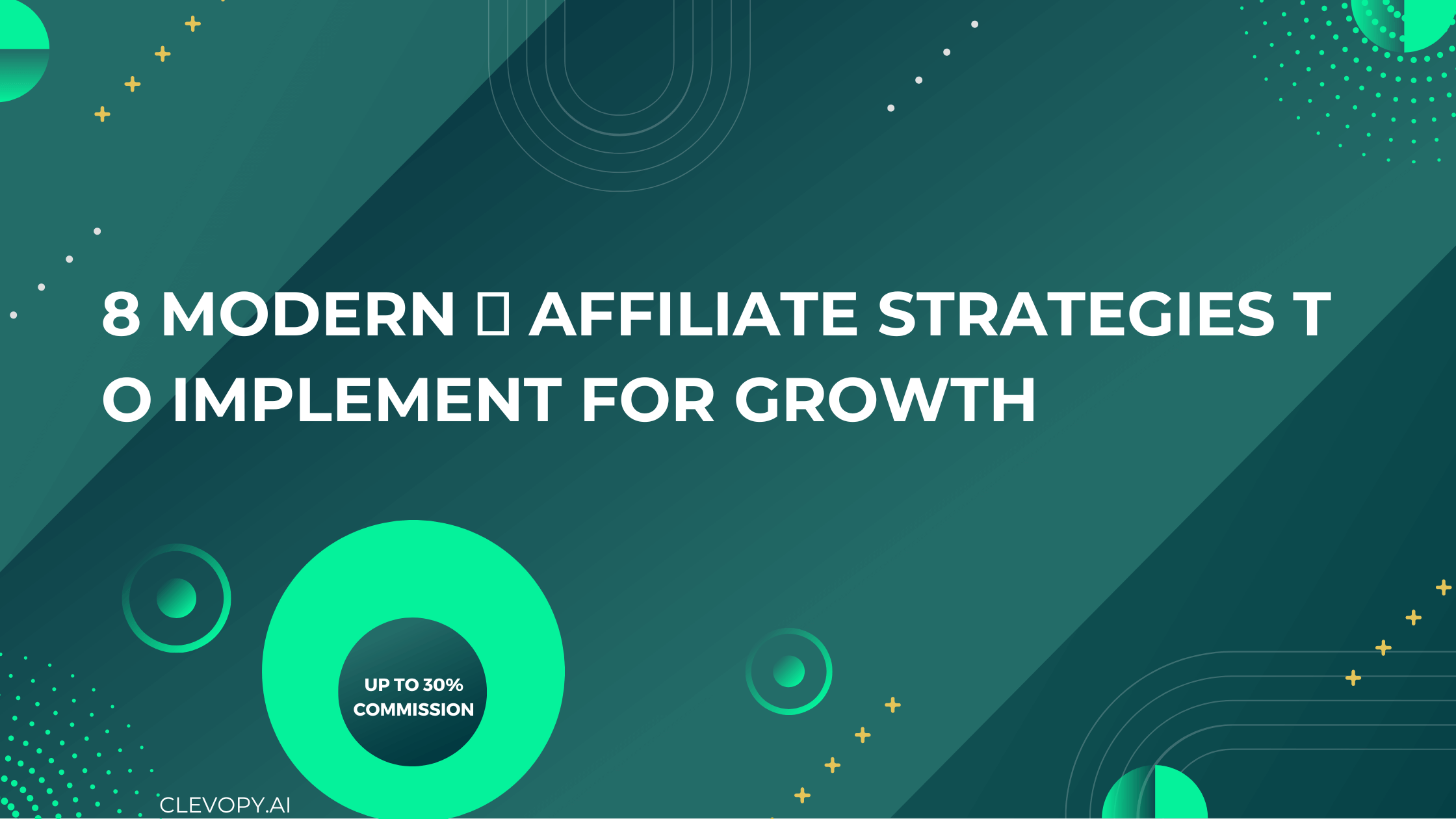Here are 8 modern affiliate strategies that you can implement to enhance your affiliate marketing efforts:
Leveraging Influencer Marketing:
Influencer marketing has become an increasingly popular strategy among affiliate marketers due to its effectiveness in reaching a larger audience quickly.
By leveraging the individual networks of influencers, businesses can reach potential customers far faster and more efficiently than traditional advertising methods, such as print ads or television commercials.
Influencer marketing also allows businesses to target certain demographics or specialized markets that may have been difficult to access with other forms of advertising.
The ability to build relationships with key influencers is another benefit of influencer marketing. As with any form of relationship building, influencers have the power to engage followers and create meaningful connections with their audiences. This allows companies to establish credibility among potential customers who may be unfamiliar with their products and services.
When influencers share content related to the business or its products, it helps create a positive impression within those same audiences.
With research and thought processes, influencer marketing campaigns can generate significant engagement and feedback from users since they are typically aimed at specific niches.
In addition to providing valuable insights into customer needs and wants, these engagements help validate a company’s product offering or campaign messaging.
With a well-executed strategy, followers of an influencer often become loyal advocates for the product or brand being promoted.
Overall, influence marketing offers affiliate marketers an effective way to reach customers quickly while creating meaningful relationships with them through personalized content and engagement.
Content Marketing and SEO:
Create high-quality content, such as blog posts, videos, or podcasts, that educates and engages your audience while incorporating affiliate links naturally.
Optimize your content for search engines to attract organic traffic and increase visibility. Focus on providing value and solving problems for your audience, positioning affiliate products as solutions.
The key is to craft content that is truly helpful and interesting. Start by identifying the topics that are relevant to your audience and create content that offers valuable solutions or insights.
This could include blog posts, videos, podcasts, infographics, or webinars. Make sure your content focuses on topics that are timely and resonate with readers so they will come back for more.
When it comes to incorporating affiliate links naturally into your content, you will want to make sure they align with the topic at hand without coming off as too "sales formatted".
It's important not to use overly aggressive sales tactics as this may turn off readers or viewers. Instead, focus on providing a natural flow in which you weave in affiliate links throughout the post or video.
For example, if you're talking about driving traffic through SEO optimization in a blog post, you might mention an online course related to SEO and link to it with an affiliate link.
The goal should be to educate and help your audience rather than just pushing products. Make sure you provide valuable information before mentioning any products so readers trust your recommendations.
You can also add incentives for readers such as discounts when they purchase through one of your affiliate links. As long as you create useful content and incorporate each product within the context of the post, it can be a great way to supplement income while providing value.
Implementing Content-Focused Strategies:
Content-focused strategies are an effective way to increase traffic to your affiliate marketing efforts. This includes creating high-quality content that is informative and relevant to your target audience.
You can use blog posts, videos, podcasts, visual assets, eBooks, and other forms of content to attract users and engage them with your brand.
Additionally, you can use popular blog platforms like WordPress or participate in online discussions related to the products you are promoting.
By building trust with prospects through valuable content, affiliates can create relationships that lead to increased conversions.
Additionally, by posting this content on social media channels and search engines, affiliates can gain more visibility for their products and services.
Affiliates should also consider creating landing pages that are targeted toward specific keywords or topics related to the affiliate program they are promoting.
This will help draw users who are looking for information on those topics directly to the affiliate's website.
Making sure to add calls-to-action within the content can help affiliates encourage prospects to take action such as signing up for a newsletter or buying a product.
User-Generated Content and Reviews:
Encourage your audience to create user-generated content, such as testimonials, reviews, or case studies, showcasing their experiences with the affiliate products or services you promote.
User-generated content adds authenticity and social proof, influencing others' purchasing decisions.
Offer incentives or rewards for users who share their experiences and include affiliate links in their content.
Having customers share their positive experiences with your affiliate products or services is powerful and can be a great asset in your promotional efforts.
User-generated content such as testimonials, reviews, and case studies from satisfied customers can be incredibly beneficial for you and your audience.
Not only will it help to build trust among potential customers, but it also serves as a source of inspiration, showing how others have been able to use the product or service to achieve their desired outcomes.
To encourage user-generated content, consider creating an incentive program in which you reward people for sharing their experiences.
Create time and reach out directly to customers who have purchased the product or used the service and ask them if they would be willing to share their stories on your website or social media channels.
You can also invite people to submit reviews on third-party websites such as Yelp or Google My Business.
Finally, don’t forget about word of mouth! Encourage customers to spread the word by referring friends and family.
User-generated content is a valuable asset that can help make your affiliate marketing campaigns more successful. With minimal effort on your part, you can get real customer feedback that will help attract new customers and engage current ones.
Retargeting and Remarketing:
Implement retargeting and remarketing strategies to reach potential customers who have shown interest in your affiliate products but have not made a purchase.
Use pixel tracking and cookie-based technology to display targeted ads to these users across various platforms. Remind them of the benefits and features of the products they viewed, increasing the chances of conversion.
Retargeting and remarketing are powerful tools for reaching potential customers who have previously shown interest in a product but have not yet made a purchase.
The first step is to capture the user data by using cookies or other tracking methods, such as pixel tags. This user data is then used to identify users who have interacted with your affiliate product or website but have not made a purchase.
Once these users have been identified, you can create targeted ad campaigns that are designed specifically to reach out to them and encourage them to complete their purchase or learn more about your affiliate product.
For example, you can use ads that contain special offers or discounts tailored specifically for these potential customers.
You could also create content such as blog posts or videos that provide additional information that may be of value to those customers.
Build a list and utilize email remarketing techniques such as email follow-ups or newsletters which contain additional incentives for people who have shown initial interest but failed to make a purchase. This type of communication serves as one last attempt at advocating for the product before potentially losing it as a customer forever.
Creating Compelling Offers:
Affiliate marketers often offer bonuses or discounts on products they promote to get more customers interested in their product or service. These bonuses may come in the form of cashback, free shipping, discounted prices, exclusive offers for affiliates, and more.
By offering these incentives, affiliate marketers can draw more customers to their product or service. Bonuses and discounts can also help increase customer loyalty and keep them coming back.
Some affiliate marketers may also give out coupons or vouchers which can be used to purchase items from their website. This is a great way to save money while shopping online as well as motivate potential customers to take action on the offer being promoted.
Furthermore, affiliates may host contests or giveaways that allow customers to win prizes such as gift cards or free products.
Many affiliate marketers may give out referral codes that give customers discounts when they refer a friend to the website. This incentive helps encourage people to spread the word about the product or service being promoted and can result in increased sales for an affiliate marketer.
Utilizing Paid Advertising:
Paid advertising is an effective and efficient way for affiliates to reach out to a wider customer base more quickly than organic methods can.
By utilizing resources such as Google AdWords, Bing Ads, and online display networks, affiliates can target potential customers by identifying keywords they are targeting and creating captivating ads with a call to action.
Paid advertising also allows affiliates to get immediate results by driving the desired traffic directly to their website or affiliate link.
Apart from search engine marketing (SEM), email marketing campaigns are another great way for affiliates to target prospective customers.
The best thing about paid advertisements is that they allow you to customize your target audience according to your campaign goals.
Whether it's targeting people based on location, interests, or demographics - you can reach exactly who you want when utilizing this option.
Additionally, with analytical tracking tools such as Google Analytics or Adobe Analytics, affiliates can measure the effectiveness of their campaigns and make appropriate changes to optimize outcomes.
As you can see, paid advertising offers numerous advantages over other marketing methods used by affiliates.
It allows them to increase brand awareness quickly and efficiently while also being able to precisely control who sees their advertisements. It provides valuable insights through analytics that allow for the optimization of campaigns which leads to improved ROI.
Tracking Your Results:
One of the most important aspects of affiliate marketing is tracking results so that you know which strategies are working well and which ones need improvement.
You should track metrics such as clicks, impressions, conversions, sales numbers, and other key performance indicators (KPIs) associated with your campaigns to learn what works best for reaching your goals.
Remember to always comply with applicable laws and regulations regarding affiliate marketing, such as disclosing your affiliate relationships and adhering to ethical marketing practices.
Continuously analyze and optimize your affiliate strategies based on data, user feedback, and industry trends to maximize your earning potential and provide value to your audience.




